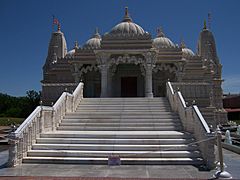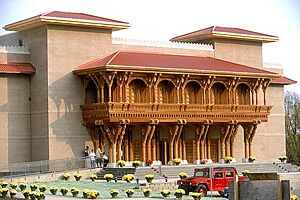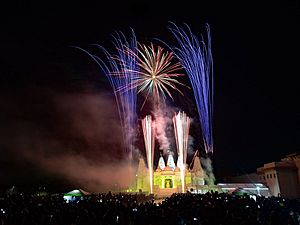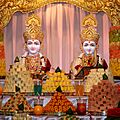BAPS Shri Swaminarayan Mandir Chicago facts for kids
Quick facts for kids BAPS Shri Swaminarayan Mandir |
|
|---|---|
 |
|
| Geography | |
| Country | United States |
| State | Illinois |
| Location | Bartlett, Illinois |
| Architecture | |
| Architectural styles | Shilpa Shastras |
| History and governance | |
| Creator | Pramukh Swami Maharaj / BAPS |
| Website | chicago.baps.org |
The BAPS Shri Swaminarayan Mandir in Chicago, Illinois, is a beautiful Hindu temple. It was built by the BAPS Swaminarayan Sanstha. This group is a part of the Swaminarayan branch of Hinduism.
The temple is located in Bartlett, a suburb of Chicago. It first opened on August 7, 2004. The building is made from hand-carved Italian marble and Turkish limestone. It is the largest Hindu temple of its kind in Illinois. The temple was built following old Hindu rules for sacred architecture. The whole area covers 27 acres. Besides the main temple, there is also a haveli (a cultural center) and a small bookstore. The haveli is where people gather for weekly meetings. The temple is open every day for worship and for visitors to explore.
Contents
The Temple and Daily Worship
This temple is a special type of Hindu temple called a 'Shikharbadha mandir'. It was built using rules from ancient Hindu texts called the Shilpa Shastras. These texts give guidelines for building sacred places.
Inside the temple, there are different shrines. Each shrine holds murtis, which are sacred statues of Hindu gods and goddesses. The main shrine has the murti of Swaminarayan. Next to him is Gunatitanand Swami. Together, they are worshipped as Akshar-Purushottam Maharaj. Other shrines have murtis of Ghanshyam Maharaj, Harikrishna Maharaj, Shri Radha Krishna, Shri Shiva Parvati, Shri Sita Ram, Hanumanji, Ganapatiji. There are also murtis of the BAPS gurus, who are spiritual leaders after Swaminarayan.
Hindus believe these murtis become special when the gods' living presence enters them. Because of this, the Swaminarayan swamis (Hindu monks) offer worship to the deities all day long.
The swamis wake up the deities before sunrise by singing morning songs called prabhatiya. Then, they perform Mangala aarti. This is the first of five aartis done each day. Aarti is a ritual where people sing praises to God while moving a lit lamp in front of the murtis. After Mangala aarti, the deities are bathed. They are then offered food and clothes that change with the seasons. Once the murtis are dressed, shangaar aarti is performed.
At midday, rajabhoga aarti is performed. Food is offered to the murtis again. This food is considered blessed and is shared with visitors as holy prasadam. In the evening, sandhya aarti is performed before more food is offered. Finally, the swamis dress the murtis in night clothes to put them to rest. Shayana aarti is done at this time. The doors to the shrines are closed when food is offered and when the murtis are put to rest.
Temple Activities
People gather for weekly meetings in the haveli. They sing religious songs and listen to talks about Hindu scriptures.
There are also many activities for young people. These include Hinduism classes, Indian music classes, and Gujarati language lessons. Leadership workshops and conferences are held during school breaks. These events encourage young people to be active in their community and temple. Young people also help organize major Hindu festivals. They sing devotional songs, perform traditional dances, and give speeches during these celebrations.
Some of the main festivals celebrated every year include Ram Navmi, Janmashtami, Shivratri, Holi, Ganesh Chaturati, and Diwali.
Diwali and New Year Celebration
Diwali is a very important Hindu festival. It is also known as the Festival of Lights. During Diwali, people light diyas (oil lamps) at home to keep away bad things. They also celebrate with light shows and fireworks. The BAPS Mandir in Chicago celebrates Diwali by lighting up the temple with many lights. They also have a fireworks show after the Diwali Maha Aarti.
The day after Diwali is the Indian New Year. Many Hindus visit the temple on this day to receive blessings for the new year. BAPS celebrates this day with Annakut. Annakut means "mountain of food." It is when thousands of vegetarian dishes are offered to the gods. These offerings can be anything from sweets to savory foods like pizza. Along with Annakut, BAPS also performs a New Year Aarti every hour inside the temple. This allows visitors to pray and receive blessings.
Tours
You can schedule tours of the temple for yourself, groups, or schools. Group visits are available on weekends and holidays. You can schedule tours from 10 AM to 5 PM Monday to Saturday, and before 12 PM on Sunday. You can book tours through the temple's website.
History of the BAPS Community in Chicago
In 1972, a small group of Hindu devotees in Chicago started meeting in homes. This was at the request of Pramukh Swami Maharaj. The group grew bigger after Pramukh Swami Maharaj visited Chicago in 1974, 1977, and 1980.
As more people joined, they needed a larger, permanent place. In 1984, they bought a building on a four-acre plot of land in Glen Ellyn, another Chicago suburb. Pramukh Swami installed murtis in this building. He opened the first Shri Swaminarayan Mandir in the Chicago area.
Within a few years, the community outgrew this temple. So, in 1994, they bought the land where the current large temple complex in Bartlett now stands.
Building the Temple
Building the complex happened in different stages. It started with the haveli and ended with the main temple. The haveli was officially opened on October 29, 2000, by Pramukh Swami Maharaj.
The stone for the temple came from Turkey and Italy. It was then shipped to Gujarat, India. From there, the stones went to Rajasthan. About 2,000 skilled workers carved the stones with detailed patterns and designs. In total, 70,000 cubic feet of stone were shaped. Once carved, the stones were sent to Chicago. About 40,000 pieces of stone arrived in Chicago. They were then put together like a giant 3D puzzle.
The entire temple complex covers 27 acres. The outside of the temple is made of Turkish limestone. The inside is made of Italian Carrara marble.
The main temple building is 22,000 square feet. It is 78 feet high, 112 feet wide, and 215 feet long. It has 16 domes on top, 151 pillars, 117 arches, five pinnacles, and four balconies.
The temple was built in just 16 months. It was officially opened on August 7, 2004, by Pramukh Swami Maharaj. Important guests like Congressman Henry Hyde and State Representative John Miller attended the ceremony.
The temple opening was part of a 16-day celebration. This included a Vishvashanti Maha yagna (a big prayer for world peace) and a shobhyatra (a colorful parade) through downtown Chicago.
Community Involvement
International Women’s Day Celebrations
Since 2008, the temple has celebrated International Women's Day. They host an annual conference. These conferences aim to empower women and help them grow spiritually. For example, the conference on March 22, 2014, was called ‘Lead from Within.’ It showed that true leadership comes from a person's character and actions.
In 2013, the theme was “Timeless Traditions: Celebrate the Past and Cultivate the Future.” This conference focused on understanding and sharing Hindu traditions. It also looked at how to preserve them for future generations.
On April 6, 2019, the temple held its annual Women's Conference. The theme was "Sādhanā: The Purpose and the Pursuit." This conference explained how sadhana (spiritual practice) helps people stay strong and brave through life's challenges.
Annual Walkathon
The BAPS temple in Chicago holds an annual walkathon. This is like other BAPS centers across North America. People from the community raise money for local charities. For several years, the money raised from the BAPS walkathon in Chicago has gone to the American Cancer Society.
Health Fairs
BAPS Charities is a worldwide charity group. It helps people through health awareness, education, and community support. Annual health fairs are a key part of the health services BAPS Charities provides in Chicago.
In 2013, a health fair was held in September. 90 doctors and 30 other health professionals volunteered their time. They gave medical care and advice to 525 people. Many types of lab tests and screenings were done. These services are usually free or cost very little. The health fairs help provide medical care and advice to people in the community who might not otherwise get it.
Architectural Awards
In 2004, the BAPS temple complex won the Chicago Building Congress Merit Award. This award recognized its unique Indian stone architecture and engineering. It also honored its positive cultural and spiritual impact on Bartlett.
In 2005, the temple was featured in Stone World magazine. It was called a true symbol of ancient heritage and traditional Indian temple craftsmanship. The American Institute of Architects has also named the temple as one of the 150 Great Places in Illinois.
Images for kids
{{Gallery mode="packed" heights="200"> File:BAPS Chicago Mandir 3.jpg| File:BAPS Chicago Mandir 7.jpg| File:BAPS Chicago Mandir 6.jpg| File:BAPS Chicago Mandir 5.jpg| File:BAPS Chicago Mandir 1.jpg| File:BAPS Chicago Mandir 4.jpg| File:BAPS Chicago Mandir 13.jpg| File:BAPS Chicago Mandir 12.jpg| File:BAPS Chicago Mandir 11.jpg| File:BAPS Chicago Mandir 14.jpg| File:BAPS Chicago Mandir 8.jpg| File:BAPS Chicago Mandir 9.jpg| File:BAPS Chicago Mandir 10.jpg| File:BAPS Chicago Mandir 15.jpg|Bhagwan Swaminarayan and Gunatitanand Swami File:BAPS Chicago Mandir 16.jpg|Hari Krishna Maharaj and Radha Krishna File:BAPS Chicago Mandir 17.jpg|Rama Sita File:BAPS Chicago Mandir 18.jpg|Pramukh Swami Maharaj </gallery>




